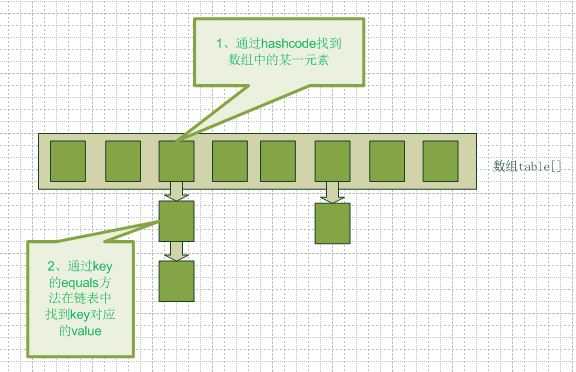标签:size void relevant equals 实现原理 upload spec gui log
主要记录hashMap的一些基本操作源码实现原理以及多线程情况下get()操作的死循环引发原因
一、hashMap简介
1.hashMap集合的主要属性及方法
(默认初始化容量)DEFAULT_INITIAL_CAPACITY = 16
(默认最大容量)MAXIMUM_CAPACITY = 1 << 30
(默认加载因子)DEFAULT_LOAD_FACTOR = 0.75f
(Entry数组)Entry[] table
(Entry实例的数量)size
put(K key, V value)方法
get(K key)方法
2.hashMap结构及操作(new方法 put方法 get方法):
数组+链表的形式,以实例Entry<K,V>的形式存储

a.new方法:
从图中我们可以看到一个hashmap就是一个数组结构,当新建一个hashmap的时候,就会初始化一个数组(默认长度16,加载因子0.75):
源码:
/** * Constructs an empty <tt>HashMap</tt> with the default initial capacity * (16) and the default load factor (0.75). */ public HashMap() { this.loadFactor = DEFAULT_LOAD_FACTOR; threshold = (int)(DEFAULT_INITIAL_CAPACITY * DEFAULT_LOAD_FACTOR); table = new Entry[DEFAULT_INITIAL_CAPACITY]; init(); }
例:table[0],table[1],table[2],table[3]...table[15]
b.put方法
当执行put方法时,会先计算key值的hash值,将hash值和(数组长度减一得到的值)进行与运算,得到数组下标值,将键值对以Entry实例的形式放入数组中:
put方法源码:
/** * Associates the specified value with the specified key in this map. * If the map previously contained a mapping for the key, the old * value is replaced. * * @param key key with which the specified value is to be associated * @param value value to be associated with the specified key * @return the previous value associated with <tt>key</tt>, or * <tt>null</tt> if there was no mapping for <tt>key</tt>. * (A <tt>null</tt> return can also indicate that the map * previously associated <tt>null</tt> with <tt>key</tt>.) */ public V put(K key, V value) { if (key == null) return putForNullKey(value); int hash = hash(key.hashCode()); //计算key的hash值 int i = indexFor(hash, table.length); //根据hash值和数组长度计算数组位置 for (Entry<K,V> e = table[i]; e != null; e = e.next) { //如遇到hash冲突(e不为空),遍历链表 Object k; if (e.hash == hash && ((k = e.key) == key || key.equals(k))) { //如遇到key值相等的,进行替换 V oldValue = e.value; e.value = value; e.recordAccess(this); return oldValue; } }
indexFor方法源码(计算数组下标),方法和简单,就把key值的hash值和数组长度-1做了与运算
/** * Returns index for hash code h. */ static int indexFor(int h, int length) { return h & (length-1); }
例:添加键值对为7,77,调用方法put(7,77),7经过计算后的hash值为7(可自行验证,不多做解释),调用indexFor方法进行与运算:0111&1111=0111,下标值为7。
table[0],table[1],table[2],table[3]...table[7]=7...table[15]
再添加元素8,put(8,88),15经过计算后的hash值仍为8,1000&1111=1000,下标值为8。
table[0],table[1],table[2],table[3]...table[7]=7,table[8]=8...table[15]
再添加元素22,put(22,2222),22经过计算后的hash值为23,10111&1111=7,下标值为7,此时由于table[7]中已存在元素(7,77),产生hash冲突,hashMap会将23放入table[7]中,再执行(e=e.next),以链表形式将next指针指向之前的元素(7,77),如下图所示:

当Entry的个数超过最大容量值*负载因子(16*0.75=12)时,hashMap会进入resize方法,重新创建一个数组并扩容为原来的2倍,再将数据拷贝到新的数组中,如下图所示:

resize方法源码:
/** * Rehashes the contents of this map into a new array with a * larger capacity. This method is called automatically when the * number of keys in this map reaches its threshold. * * If current capacity is MAXIMUM_CAPACITY, this method does not * resize the map, but sets threshold to Integer.MAX_VALUE. * This has the effect of preventing future calls. * * @param newCapacity the new capacity, MUST be a power of two; * must be greater than current capacity unless current * capacity is MAXIMUM_CAPACITY (in which case value * is irrelevant). */ void resize(int newCapacity) { Entry[] oldTable = table; int oldCapacity = oldTable.length; if (oldCapacity == MAXIMUM_CAPACITY) { threshold = Integer.MAX_VALUE; return; } Entry[] newTable = new Entry[newCapacity]; transfer(newTable); table = newTable; threshold = (int)(newCapacity * loadFactor); }
c.get方法:
当执行get方法时,根据key值的hash值,得到数组下标,将数组内的entry的key值与get中的参数做对比(如该数组内有链表,则会继续遍历链表),若hash相等且equals,则返回。
get方法源码:
/** * Returns the value to which the specified key is mapped, * or {@code null} if this map contains no mapping for the key. * * <p>More formally, if this map contains a mapping from a key * {@code k} to a value {@code v} such that {@code (key==null ? k==null : * key.equals(k))}, then this method returns {@code v}; otherwise * it returns {@code null}. (There can be at most one such mapping.) * * <p>A return value of {@code null} does not <i>necessarily</i> * indicate that the map contains no mapping for the key; it‘s also * possible that the map explicitly maps the key to {@code null}. * The {@link #containsKey containsKey} operation may be used to * distinguish these two cases. * * @see #put(Object, Object) */ public V get(Object key) { if (key == null) return getForNullKey(); int hash = hash(key.hashCode()); //计算hash值 for (Entry<K,V> e = table[indexFor(hash, table.length)]; e != null; e = e.next) { //这里遍历数组中的链表,若找到key值相等的,则返回 Object k; if (e.hash == hash && ((k = e.key) == key || key.equals(k))) return e.value; } return null; }
二、Java多线程下的HashMap死循环
画了个图做了个演示。

1)假设我们有两个线程。我用红色和浅蓝色标注了一下。
我们再回头看一下我们的 transfer(resize方法中)代码中的这个细节:
do { Entry<K,V> next = e.next; // <--假设线程一执行到这里就被调度挂起了 int i = indexFor(e.hash, newCapacity); e.next = newTable[i]; newTable[i] = e; e = next; } while (e != null);
而我们的线程二执行完成了。于是我们有下面的这个样子。

注意,因为Thread1的 e 指向了key(3),而next指向了key(7),其在线程二rehash后,指向了线程二重组后的链表。我们可以看到链表的顺序被反转后。
2)线程一被调度回来执行。

3)一切安好。
线程一接着工作。把key(7)摘下来,放到newTable[i]的第一个,然后把e和next往下移。

4)环形链接出现。
e.next = newTable[i] 导致 key(3).next 指向了 key(7)
注意:此时的key(7).next 已经指向了key(3), 环形链表就这样出现了。

于是,当我们的线程一调用到,HashTable.get(11)时,悲剧就出现了——Infinite Loop。
标签:size void relevant equals 实现原理 upload spec gui log
原文地址:http://www.cnblogs.com/nsxqf/p/6580982.html